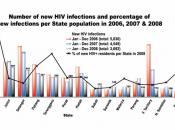If you do not engage in sexual activity or intravenous drug use your chances of HIV infection are virtually nil. However, for those people who do engage in either of these activities, the methods for preventing HIV infection include condoms, lubricant, sterile needles and syringes, methadone and bleach.
Condoms
These are available for a very low cost from supermarkets, chemists and vending machines in toilets of hotels, colleges and universities. Free condoms can be obtained from Sexual Health Centres, Needle Exchanges and some Community Health Centres. Condoms must be used correctly to provide protection. It is important that people who have not previously used a condom practise putting one on before they have sex, to ensure they do it correctly.
Lubricant
Lubricant reduces the risk of the condom tearing and is sometimes provided with packets of condoms. The lubricant must be water-based (for example, KY Jelly), not oil-based, as oil-based lubricants can perish the condom, thus allowing semen to escape.
Needles and syringes
Clean, new needles and syringes are provided free through AIDS Prevention i Program Needle Exchanges in NSW. Over two million needles are distributed each year. Many of these are returned when used. In NSW, exchanges are conducted in over eight approved distribution centres and through approximately 500 needle-exchange-scheme chemists. Needle Exchanges also provide free condoms, referral to drug and HIV-treatment agencies and education about safe sex. If a situation arose in which an HIV-infected user was too ill to go out to obtain new syringes, it is likely that the Needle Exchange would provide equipment on an outreach basis. Needle Exchanges can be recognised by the following symbol.
Methadone and bleach can also act to reduce the risk of HIV infection in drug users. The use of methadone for heroin users removes...


